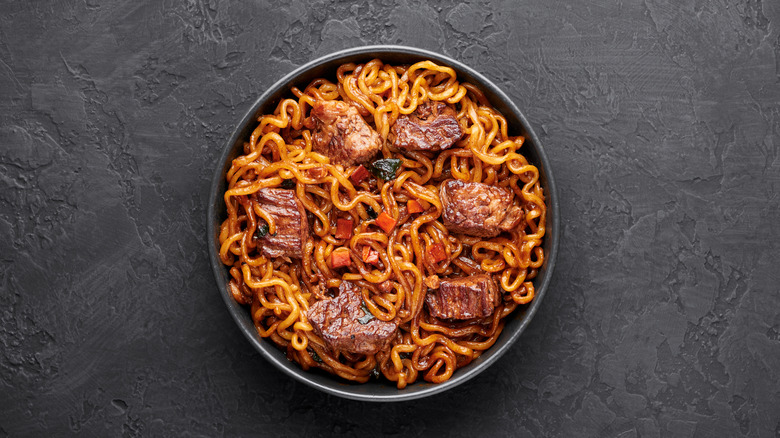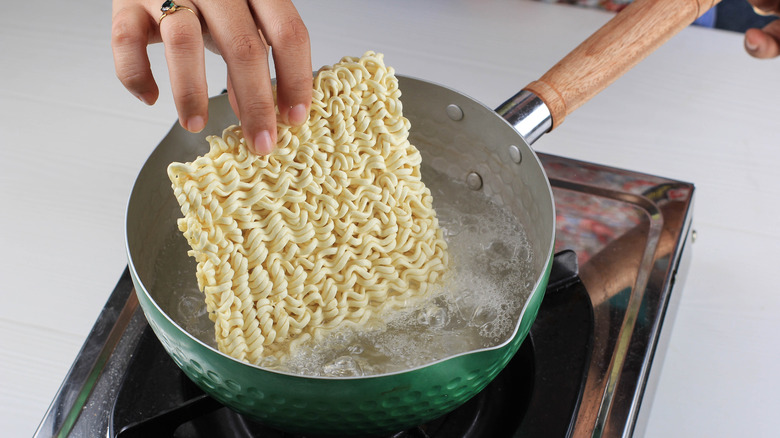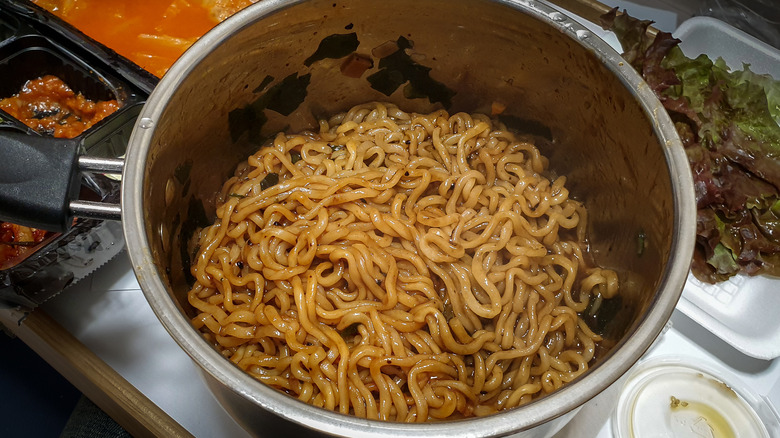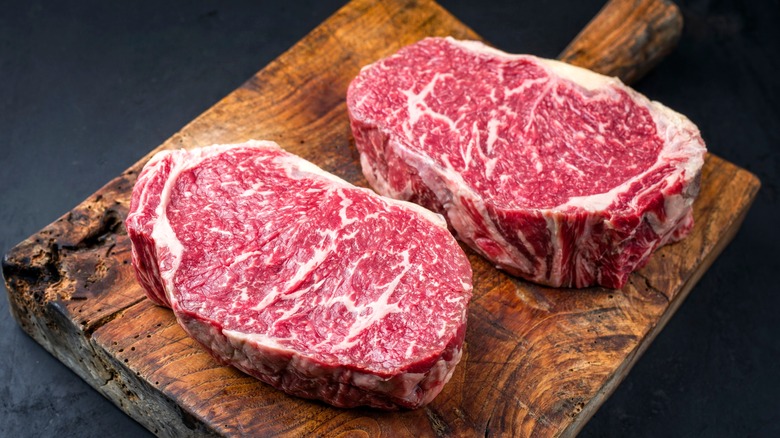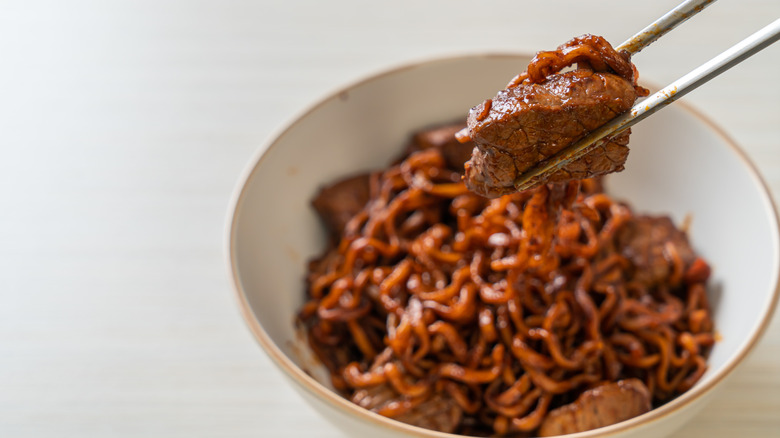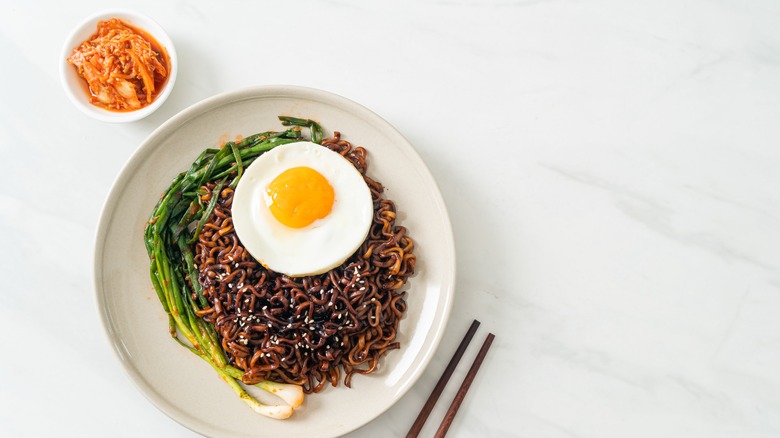The Noodle Fusion Involved In Making Korea's Jjapaguri
A delicious Korean noodle dish got put into the spotlight when the Academy Award-winning movie "Parasite" was shown at movie theaters around the world. In the movie, the affluent Park family ate jjapaguri, a dish made of instant noodles and steak. Many theater-goers who returned home after watching the dark satire wanted to sample the savory and spicy dish.
Just like the two main families in "Parasite," jjapaguri is a dish is comprised of opposites. Jjapaguri is made of two kinds of instant noodles — slightly sweet jjapaghetti and spicy neoguri. Hence the name of "jjapa" "guri", according to My Korean Kitchen. At first, jjapaguri tastes savory, but that flavor is quickly followed by heat. Another opposite found in jjapaguri is that the inexpensive instant noodles are topped with an expensive cut of steak, per Kimchi Mari.
Whether you want to be true to the version of jjapaguri eaten in "Parasite" or put your own spin on it, the instant noodle dish with a dark sauce is quick and easy to make.
The origin of jjapaguri
While jjapaguri may have become popular the release of "Parasite" in 2019, that's not the only time it's found itself a part of pop culture. According to My Korean Kitchen, jjapaguri is a favorite snack for boy band Big Bang member G-Dragon. The dish was also featured on the show "Dad, Where Are We Going?"
Although the history of combining the two kinds of instant noodles is a relatively new creation, the consumption of instant noodles in Korea began much earlier. Comparable to the instant ramen noodles popular in Japan, the Korean versions have some flavor differences. According to Kimchi Mari, Samyang Ramyeon first was sold in Korea in the 1960s. Since then, ramyun (also spelled ramyeon) has continued to grow in popularity and flavors. Nowadays, instant noodles are an inexpensive meal to be eaten at home or in a restaurant in Korea, sometimes with toppings like cheese or green onions. In "Parasite," Kimchi Mari says jjapaguri is made with Korean top sirloin beef, which is about double the cost of beef imported from the United States or Australia.
Whether topped with beef or without, jjapaguri is known by two names. "Parasite" made the name jjapaguri for the dish popular, but according to A Spicy Perspective, it has been commonly known as "ram don" because it is made from ramyun with udon noodles.
Two kinds of noodles
The two types of noodles combined to make jjapaguri are quite different from each other. According to My Korean Kitchen, jjapaghetti is a kind of Korean black bean noodle that has a savory and slightly sweet flavor. Neoguri, in comparison, are spicy and made from a seafood udon noodle.
Also spelled chapagetti, Jjapaghetti contains the same dried noodles that other ramyun packages have, according to The Takeout. The difference really lies in its sauce. The powder included with the jjapaghetti package becomes a silky dressing when combined with water and boiled. Its flavor, as described by The Takeout is salty and savory. Jjapaghetti is an instant version of another dish popular in Korea called jjajangmyeon, which combines elements of Korean and Chinese cuisines. That dish is made with wheat noodles, vegetables (carrots, potatoes, and zucchini are options) and a sauce made of black beans.
Neoguri, as described by maker Nongshim, has thick noodles in the style of udon, which differentiates it from other types of ramyun that have thinner noodles. The defining taste of Neoguri is spicy seafood. The package contains dried kelp that helps to provide texture, as well as taste.
High-end meat
In "Parasite," jjapaguri is made with expensive Korean-raised beef called hanwoo chaekkeussal, creating the juxtaposition of cheap noodles made with some of the most expensive meat available. For those not living in Korea, Kimchi Mari recommends buying a wagyu beef because it has a similar taste to hanwoo beef. Other types of beef can work just as well. Chef Julie Yoon used flank steak for her jjapaguri because that's what she could find at the grocery store. The savory taste and easiness of cooking the flank steak suited the dish well. By slicing it thinly, it also helped to create and attractive dish by draping the steak over the noodles, according to Chef Julie Yoon.
To try and achieve the luxurious taste of hanwoo beef, Maangchi used top quality ribeye and added butter to the pan while it was being seared. For a meatless version of jjapaguri, tofu can be substituted for the steak. Other ideas for jjapaguri from A Spicy Perspective include adding an egg, chicken, or pork to the noodle dish.
How to make jjapaguri
Creating jjapaguri is a relatively easy and quick process, per Kimchi Mari. To cook the meat, cut it into small pieces and then flavor with some mirin, sesame oil, sea salt, and black pepper. Then, sear the meat for a few minutes in a hot pan.
For the noodles, boil 5 cups of water and then add the two packets of noodles and cook for 2 minutes. Next, drain about half of the water from the pan, according to Kimchi Mari, and return the pan to the burner. Pour into the pot all of the jjapaghetti seasoning packet and 1/2 of neoguri seasoning packet. All of the Neoguri seasoning can be used if a spicier and saltier taste is desired. Once mixed well together, allow to cook for another two minutes or until most of the water has been cooked away. Finally, add the steak cubes and jjapaghetti oil before putting the noodles and meat on a plate. Kimchi Mari recommends placing sliced green onions on the noodles and serving with pickled yellow radish (danmuji) or kimchi.
Other tips from Kimchi Mari for jjapaguri is to eat the dish right away so that the sauce isn't fully absorbed by the noodles. Also, don't leave too little or too much water in the pot after draining so just the sauce is left after simmering. Kimchi Mari recommends that the water level be to just below the noodles after draining.
A variety of garnishes
A variety of garnishes can be used for jjapaguri — all depending on the maker's personal taste. There are no standard garnishes. Some people prefer fresh vegetables while others prefer to add more heat.
For example, when My Korean Kitchen makes jjapaguri it is topped with sweet corn and peas for flavor and color. On the other hand, A Spicy Perspective prefers to add more heat to jjapaguri with the addition of gochujang. Chef Julie Yoon wanted to add color and more texture to her bowl of jjapaguri so she added thinly sliced red chili pepper, julienned cucumber, and thinly sliced scallions. Toasted white or black sesame seeds are also suggested as a garnish. Other fresh ingredients to consider for adding to the dish are mushrooms, garlic, carrots, green onion, cucumber, and seaweed.
Jjapaguri may be a dish made from opposites, but together the two kinds of noodles and spicy and savory flavors make for a well-balanced and delicious meal.
